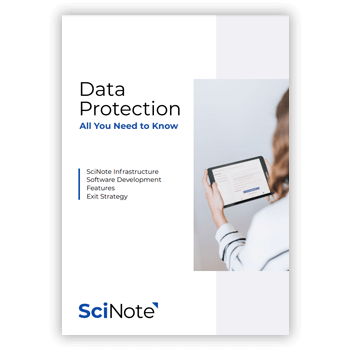Enhance data management with SciNote in an NIH-funded research lab
Here is how the Tykocki Lab uses SciNote to enhance its data management practices to maintain data integrity and meet NIH data management and sharing requirements.
“We tried the other [electronic lab notebooks] too, but the visual interface of SciNote was hands down the thing that won.”
Dr. Nathan R. Tykocki, Pharmacology and Toxicology, Michigan State University
Table of contents:
About the research lab
Dr. Nathan Tykocki’s research focuses on urinary bladder physiology, with specific emphasis on the mechanisms responsible for the sensation of bladder fullness. He employs a multi-disciplinary approach, including biochemical, pharmacological, physiological and genetic tools, to understand how the bladder muscle, nerves, vasculature and urothelium communicate to impact bladder function.
Nathan’s scientific training explored vascular smooth muscle biology, physiology and pharmacology, specifically in terms of calcium signaling pathways as regulators of smooth muscle contractility. His fields of expertise include myography, receptor pharmacology, confocal microscopy, fluorescence microscopy, calcium imaging, western blotting, immunofluorescence, and instrument design/fabrication.
The Challenge
After completing his postdoc, Nathan joined the University of Vermont as a Research Assistant Professor. When he was relocating to the Michigan State University, he realized that data on paper notebooks, which he initially relied on, was extremely complicated to transfer and to manage, e.g., knowing which data goes where, tracking everything, and having to depend on poorly handwritten notes.
With his grants funded by the National Institute of Health (NIH), which requires labs to maintain data over time and ensure data integrity, there was a pressing need for a robust and centralized solution that could provide consistent data management, guarantee data protection, and improve lab documentation practices.
The Solution
To address the data management and documentation challenges, Nathan sought a tech-driven solution that is an electronic lab notebook (ELN). After testing various ELN options, Nathan and his lab decided to implement SciNote for its visual interface and streamlined project organization.
Watch the full presentation below on how an electronic lab notebook can help you manage your data and meet NIH data management and sharing requirements.
Key Takeaways
Off-site data storage ensures data is safe and protected
“When we started this, I had a friend whose lab was completely flooded from a broken water pipe doing about 10 million dollars’ worth of damage to equipment and stuff. At that point, I thought no, we cannot have our data on paper. We can’t have something that can drown in a puddle, or that I can destroy by accidentally pouring coffee all over it, or is going to get lost in the shuffle of students in and out.”
With a cloud-based electronic lab notebook, data is stored off-site and regularly backed up at a different location. This means that the lab can maintain its data for as long as required by the NIH data management and sharing policy. Additionally, various data protection and security measures are in place to prevent data loss due to natural disasters, accidents, or student turnover.
SciNote also ensures the lab’s data and metadata are documented and stored together. It automatically tracks all activities, helping lab members easily identify who performed specific actions and when they were done.
Download SciNote's Data protection whitepaper
Get your whitepaper on how your data is protected inside SciNote.
Download the whitepaperFlexible structure allows labs to decide how they will organize their projects and experiments
“This is really where the power of SciNote is coming for us, is this ability of how we decided to organize and group our protocols and experimental designs.”
In the Tykocki lab, grants are organized into project folders within SciNote. These projects are further divided into sub-projects, categorized based on the types of experiments, mouse strains, or specific students responsible for particular lab activities. SciNote’s adaptable project-based structure provides labs with the flexibility to group and organize items according to their preferences and needs.
Repeatable steps can be set up as workflows and duplicated quickly
Experimental steps can be set up as Tasks within the Canvas and connected as Workflows to help track the steps completed. Lab members can set up the workflows as templates, and duplicate the same experimental set up quickly for other experiments.
Steps can also be set up to have a common start and end point, where the preparation and set up are done once, and samples as Task cards when they are received and processed.
The workflows help the lab streamline its processes, and develop templates that can be re-created quickly.
Review who is responsible for what activity, and identify gaps quickly
“The things we needed to track, we could track. The things we didn’t need to track, we didn’t need to repeat. And within all of these, we’re able to go ahead, take notes, make comments throughout all of it, and track the time of day and so on through all of it as the steps were completed so long as our people go through and check it off.”
SciNote’s task tracking feature allows labs to track people’s work on a day-to-day, week-to-week, month-to-month basis and to know where to pick up when things are left off. This is valuable as undergrad students in the lab are in a constant flux; SciNote allows the PI to keep all the data together and track what happens to each project and task.
The checklists and task status provide PI with information whether there are tasks that are incomplete within the project. Information such as the date and time when a task is completed, who completed the task, and what the issue could be, can be quickly determined through SciNote.
Results
SciNote helps the Tykocki lab enhance its data management and ensure data is maintained according to NIH requirements. Its flexible project-based structure gives the lab the ability organize projects, experiments, and protocols as the lab sees fit. The visualized workflows streamline the processes in the lab, helping lab members make sure steps are completed and helping the PI monitor project progress and identify gaps quickly.












